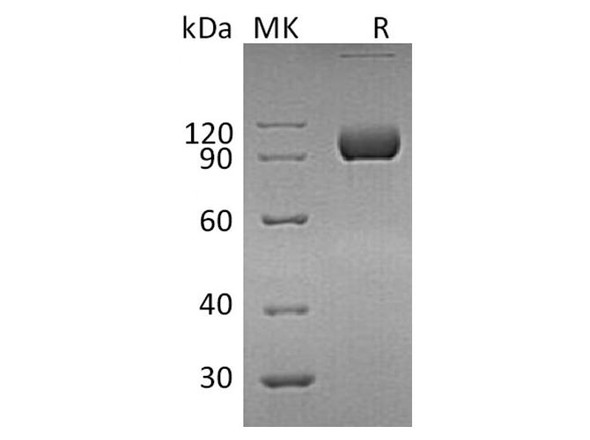Description
| Product Name: | Mouse EPHA4 Recombinant Protein |
| Product Code: | RPPB3456 |
| Size: | 5µg |
| Species: | Mouse |
| Target: | EPHA4 |
| Synonyms: | Ephrin type-A receptor 4, Epha4, Tyrosine-protein kinase receptor MPK-3, Tyrosine-protein kinase receptor SEK-1, Sek, Sek1, EPHA4, EPH Receptor A4. |
| Source: | Sf9 Insect cells |
| Physical Appearance: | Sterile Filtered clear solution. |
| Formulation: | The EPHA4 solution (0.5mg/1ml) contains phosphate buffered saline (pH7.4) and 10% glycerol. |
| Stability: | Store at 4°C if entire vial will be used within 2-4 weeks. Store, frozen at -20°C for longer periods of time. For long term storage it is recommended to add a carrier protein (0.1% HSA or BSA).Avoid multiple freeze-thaw cycles. |
| Purity: | Greater than 95.0% as determined by SDS-PAGE. |
| Amino Acid Sequence: | VTGSRVYPAN EVTLLDSRSV QGELGWIASP LEGGWEEVSI MDEKNTPIRT YQVCNVMEAS QNNWLRTDWI TREGAQRVYI EIKFTLRDCN SLPGVMGTCK ETFNLYYYES DNDKERFIRE SQFGKIDTIA ADESFTQVDI GDRIMKLNTE IRDVGPLSKK GFYLAFQDVG ACIALVSVRV FYKKCPLTVR NLAQFPDTIT GADTSSLVEV RGSCVNNSEE KDVPKMYCGA DGEWLVPIGN CLCNAGHEEQ NGECQACKIG YYKALSTDAS CAKCPPHSYS VWEGATSCTC DRGFFRADND AASMPCTRPP SAPLNLISNV NETSVNLEWS SPQNTGGRQD ISYNVVCKKC GAGDPSKCRP CGSGVHYTPQ QNGLKTTRVS ITDLLAHTNY TFEIWAVNGV SKYNPSPDQS VSVTVTTNQA APSSIALVQA KEVTRYSVAL AWLEPDRPNG VILEYEVKYY EKDQNERSYR IVRTAARNTD IKGLNPLTSY VFHVRARTAA GYGDFSEPLE VTTNTVPSRI IGDGANSTLE HHHHHH |
EPHReceptor A4 (Epha4), is a single-pass type 1 membrane protein which is a partof the protein kinase superfamily and ephrin receptor subfamily. Epha4 is a receptortyrosine kinase which binds membrane-bound ephrin family ligands residing onadjacent cells, leading to contact-dependent bidirectional signaling intoneighboring cells mainly in the nervous system and in erythropoiesis.
EPHA4 Mouse Recombinant produced in Sf9 Baculovirus cells is a single polypeptide chain containing 536 amino acids (20-547) and having a molecular mass of 59.3kDa.(Molecular size on SDS-PAGE will appear at approximately 50-70KDa).EPHA4 is fused to 8 amino acid His-tag at C-terminus & purified by proprietary chromatographic techniques.
| UniProt Protein Function: | EphA4: a tyrosine kinase receptor of the Eph family. Receptor for members of the ephrin-A family. Binds to ephrin-A1, -A4 and -A5. Binds more poorly to ephrin-A2 and -A3. May play a role in hindbrain pattern formation. The Eph receptor tyrosine kinase family, the largest in the tyrosine kinase group, has fourteen members. They bind membrane-anchored ligands, ephrins, at sites of cell-cell contact, regulating the repulsion and adhesion of cells that underlie the establishment, maintenance, and remodeling of patterns of cellular organization. Eph signals are particularly important in regulating cell adhesion and cell migration during development, axon guidance, homeostasis and disease. EphA receptors bind to GPI-anchored ephrin-A ligands, while EphB receptors bind to ephrin-B proteins that have a transmembrane and cytoplasmic domain. Interactions between EphB receptor kinases and ephrin-B proteins transduce signals bidirectionally, signaling to both interacting cell types. Eph receptors and ephrins also regulate the adhesion of endothelial cells and are required for the remodeling of blood vessels.Protein type: Kinase, protein; Membrane protein, integral; EC 2.7.10.1; Protein kinase, TK; Protein kinase, tyrosine (receptor); TK group; Eph familyCellular Component: axon; cell junction; cell projection; cell surface; cytoplasm; dendrite; dendritic spine; early endosome membrane; endoplasmic reticulum; endosome; filopodium; Golgi apparatus; integral to membrane; integral to plasma membrane; membrane; mitochondrial outer membrane; nerve terminal; neuromuscular junction; perikaryon; plasma membrane; postsynaptic density; postsynaptic membrane; synapseMolecular Function: ATP binding; ephrin receptor activity; ephrin receptor binding; GPI-linked ephrin receptor activity; identical protein binding; kinase activity; nucleotide binding; PH domain binding; protein binding; protein kinase activity; protein-tyrosine kinase activity; transferase activity; transmembrane receptor protein tyrosine kinase activity; transmembrane-ephrin receptor activityBiological Process: adult walking behavior; axon guidance; cell adhesion; corticospinal tract morphogenesis; ephrin receptor signaling pathway; glial cell migration; motor axon guidance; multicellular organismal development; negative regulation of axon regeneration; nervous system development; peptidyl-tyrosine phosphorylation; phosphorylation; positive regulation of dendrite morphogenesis; positive regulation of JNK activity; protein amino acid autophosphorylation; protein amino acid phosphorylation; regulation of astrocyte differentiation; regulation of axonogenesis; regulation of GTPase activity; transmembrane receptor protein tyrosine kinase signaling pathway |
| UniProt Protein Details: | |
| NCBI Summary: | |
| UniProt Code: | Q03137 |
| NCBI GenInfo Identifier: | 341940656 |
| NCBI Gene ID: | 13838 |
| NCBI Accession: | Q03137.2 |
| UniProt Secondary Accession: | Q03137,Q80VZ2 |
| UniProt Related Accession: | Q03137 |
| Molecular Weight: | 103,984 Da |
| NCBI Full Name: | Ephrin type-A receptor 4 |
| NCBI Synonym Full Names: | Eph receptor A4 |
| NCBI Official Symbol: | Epha4�� |
| NCBI Official Synonym Symbols: | rb; Sek; Cek8; Hek8; Sek1; Tyro1; AI385584; 2900005C20Rik�� |
| NCBI Protein Information: | ephrin type-A receptor 4 |
| UniProt Protein Name: | Ephrin type-A receptor 4 |
| UniProt Synonym Protein Names: | Tyrosine-protein kinase receptor MPK-3; Tyrosine-protein kinase receptor SEK-1 |
| Protein Family: | Ephrin type-A receptor |
| UniProt Gene Name: | Epha4�� |
| UniProt Entry Name: | EPHA4_MOUSE |






